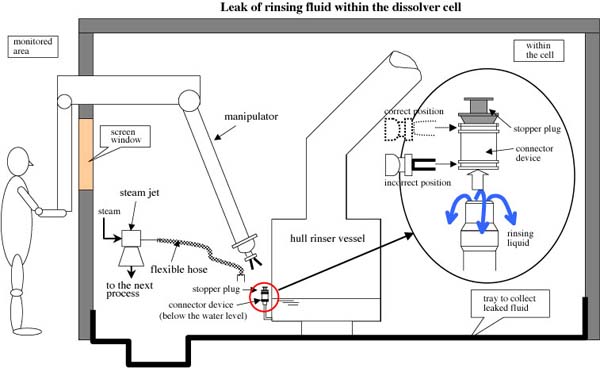The first publicly disclosed leak during the active tests at Rokkasho reprocessing plant occurred at 3:40 am on 11 April 2006. Forty liters of radioactive fluid leaked from the hull rinser vessel, which is in the dissolver cell within the Head End Building. (Hulls are the undissolved remains of spent fuel cladding after the spent fuel has been dissolved in nitric acid. They are rinsed to remove residual radioactive materials.)
The leak occurred when a worker was using a remotely controlled manipulator to connect a steam jet hose to the hull rinser vessel, in order to flush the fluid to the next process (see diagram). The hose should have been connected to the stopper plug at the top of the connector device, but instead of releasing this plug, the worker released the connector device itself. The plug was above the water level, so if this had been released no fluid would have leaked out. However, the leak occurred because the connector device was attached below the water level.

According to JNFL, the leaked fluid was contained within the cell, recovered and reused and there was no radiation exposure to workers. Although it was not released into the environment, it is nevertheless worth considering how much radioactivity was contained in the leaked fluid.
The concentrations and total quantities of radioactivity and of uranium and plutonium in the leaked fluid were as follows:
Total alpha emitters: 40 liters @ 4.1 x 105 Bq/ml = 1.6 x 1010 Bq
Total gamma emitters: 40 liters @ 3.1 x 106 Bq/ml = 1.2 x 1011 Bq
Uranium: 40 liters @ 6.5 gram/liter = 260 grams
Plutonium: 40 liters @ 0.025 gram/liter = 1 gram.
Compare this to the annual benchmark for alpha emitters of 3.8 x 109 Bq and the annual benchmark for non-alpha emitters of 2.1 x 1011 Bq (see table in NIT 111). Also compare it to the legal limit for the concentration of alpha-emitting plutonium-239 in liquid releases of 4 x 10-3 Bq/ml and the legal limit for the concentration of gamma-emitting1 cesium-137 in liquid releases of 3 x 10-2 Bq/ml.
Perhaps a useful way of thinking about the amount of radioactivity involved is to imagine that all gamma radiation came from cesium-137 and that all the leaked fluid was poured into a plastic bucket. In that case the dose at a distance of 1 meter would be 5 mSv/hour. The permitted annual dose to the general public is 1 mSv/year, while the permitted annual dose for radiation workers is 20 mSv/year (limit over 5 years of 100 mSv).
Clearly it is just as well that this fluid was not released into the environment and that no one was directly exposed to the radiation. This leak illustrates very clearly the dangerous nature of the materials being handled at the Rokkasho reprocessing plant. No doubt the incident will be put down to worker error, but we must question the training standards that allowed such an error to occur. Furthermore, worker error is no excuse when such dangerous materials are involved.
Philip White (NIT editor)
This article is based largely on a more detailed analysis by Professor Michiaki Furukawa in CNIC's Japanese newsletter.
1. Cesium-137 also emits beta rays, but JNFL doesn't mention these. Also, Becquerel is not really appropriate for gamma radiation, but we have followed JNFL here for simplicity's sake.
Refer to CNIC's updates on the active tests at the Rokkasho reprocessing plant.
Return to NIT 112 contents

